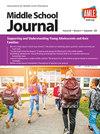Moving from theory to practice: A critical approach
Q3 Social Sciences
引用次数: 2
Abstract
The phrase theory to practice permeates education. A simple Google search will reveal that there are countless books, articles, podcasts, and videos touting the importance of putting theory into practice. As educators we are constantly being told that we need to put theory into practice in the ways that we develop curriculum, select and implement instructional practices and assessment strategies, make decisions that impact our classroom climate and relationships with students and families (i.e., Akos & Kurz, 2016; Fuhler, 2003). In the same vein, teacher education programs are consistently striving to find the right combination of coursework and fieldwork and innovative strategies (i.e., Howell et al., 2017) for teacher candidates to gain the knowledge and experiences they need to put theory into practice. But when we step back and examine that phrase, what does it even mean? And more importantly what does it assume? Technically, the term “put {insert something} into practice” is an idiom that means, “to commence doing something that had previously only been discussed, suggested, or planned” (thefreedictionary.com). In education, we use this idiom to explain the importance of taking a theory (a belief or procedure followed as the basis of action) that was previously discussed, suggested, or planned and implementing it, most likely in a classroom. At the most basic level, teachers do this every second of every day. One teacher might do it when they notice that Marta responds well when given the opportunity to draw instead of write out her thinking, so they make that a regular part of their practice. Another when they recognize that Sonny is most engaged when he completes an experiment independently and then explains his findings to a group of peers so they organize their science class to incorporate options for independent work followed by small group sharing and discussion. Educators are literally putting their own theories into practice constantly as they make decisions based on repeated observations, experiences, and dialogue. I once heard that, on average, educators make nearly 10,000 decisions per day related to teaching and learning. But when we talk about putting theory into practice, as a field, we generally are not referring to the ways that teachers put their own theories about what works and what does not for the learners in their classrooms into practice everyday; we are talking about putting certain theories, unquestionably, into practice, some of which have been around for years or even decades. Other times the theories are the newest fads in education. Many of these theories are problematic, and the research behind them might not be transferable to certain populations of students. Either way, many theories are used almost unquestioningly, without consideration for the impact on or the implications for young adolescents. For example, one of the long lasting theories that has informed the way we think about young adolescence is Hall’s recapitulation theory, which posited that during young adolescence, we transition from a savage state to a civilized state. He believed that nonwhite adolescents could never reach this civilized state, subjugating them permanently to a savage state. Despite the blatant racism underlying this theory, it still has lasting impacts on the ways people think and talk about youth (Harrison et al., 2019). Thus, while we believe that theory should be an important driver of practice, we want to encourage a more thoughtful approach to the way we think about theory. One that promotes thoughtful, critical reflection on the theory itself and the ways that it is being extended and how it is informing practice. Such critical questions should include: Who does the theory apply to? What are the limitations of the theory? What new research might make从理论到实践:一种批判的方法
从理论到实践这个短语渗透到教育中。简单的谷歌搜索就会发现,有无数的书籍、文章、播客和视频宣扬将理论付诸实践的重要性。作为教育工作者,我们不断被告知,我们需要在制定课程、选择和实施教学实践和评估策略、做出影响课堂氛围以及与学生和家庭关系的决定时,将理论付诸实践(即,Akos&Kurz,2016;Fuhler,2003)。同样,教师教育项目一直在努力为教师候选人找到课程作业、实地调查和创新策略的正确结合(即Howell et al.,2017),以获得将理论付诸实践所需的知识和经验。但当我们回过头来审视这个短语时,它到底意味着什么?更重要的是,它假设了什么?从技术上讲,“把{插入某物}付诸实践”是一个成语,意思是“开始做以前只讨论、建议或计划过的事情”(thefreedictionary.com)。在教育中,我们用这个成语来解释接受以前讨论、建议过的理论(作为行动基础的信念或程序)的重要性,或者计划并实施它,很可能是在课堂上。在最基本的层面上,老师每天每时每刻都在这样做。一位老师可能会这样做,因为他们注意到玛尔塔在有机会画画而不是写下她的想法时反应很好,所以他们把这作为练习的一部分。另一种情况是,当Sonny独立完成一项实验,然后向一群同龄人解释他的发现时,他们意识到他最投入,于是他们组织科学课,将独立工作的选项纳入其中,然后进行小组分享和讨论。教育工作者在反复观察、经验和对话的基础上做出决定,不断地将自己的理论付诸实践。我曾经听说,教育工作者平均每天做出近10000个与教学有关的决定。但是,当我们谈论将理论付诸实践时,作为一个领域,我们通常不是指教师每天将自己关于什么对课堂上的学习者有效,什么对学习者无效的理论付诸实践的方式;毫无疑问,我们谈论的是将某些理论付诸实践,其中一些理论已经存在多年甚至几十年了。其他时候,这些理论是教育领域的最新潮流。其中许多理论都有问题,其背后的研究可能无法转移到某些学生群体中。无论哪种方式,许多理论都被毫无疑问地使用,没有考虑对青少年的影响或影响。例如,霍尔的重述理论是我们看待青少年的一个长期理论,该理论认为,在青少年时期,我们从野蛮状态过渡到文明状态。他认为,非白人青少年永远无法达到这种文明状态,使他们永久地陷入野蛮状态。尽管这一理论背后存在明显的种族主义,但它仍然对人们思考和谈论青年的方式产生了持久的影响(Harrison等人,2019)。因此,尽管我们认为理论应该是实践的重要驱动力,但我们希望鼓励对我们思考理论的方式采取更深思熟虑的方法。一种促进对理论本身、扩展方式以及如何为实践提供信息的深思熟虑的批判性反思的方法。这些关键问题应该包括:这个理论适用于谁?这个理论的局限性是什么?新的研究可能会带来什么
本文章由计算机程序翻译,如有差异,请以英文原文为准。
求助全文
约1分钟内获得全文
求助全文

 求助内容:
求助内容: 应助结果提醒方式:
应助结果提醒方式:


